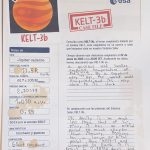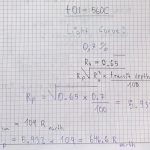
Project Gallery 2023
Secondary students from across Europe became exoplanet detectives with ESA and used Cheops satellite data to uncover the mysteries of two exoplanet targets: KELT-3b and TOI-560c.
Explore the projects below.
Newton
Loretto College La Paz – Sur Bolivia 14 years old 1 / 1
KELT-3b
KELT-3b project description:
It is a gaseous and swollen exoplanet, using allesfitter I obtained information on the light curves thanks to the Cheops satellite, then measuring its transit depth which is 0.9%, I used the equation and it gave me a result that the radius is 0.0155 times the sun, it is a very large exoplanet. then I converted the mads of the KELT-3 star to SI units, converting the days of the orbital period to seconds, then we used the equation and I got a result of 1,540 x 10 raised to 21 m, and in AU it would be 1,030. KELT-3 has the shorter orbital period than Mercury. now finding out if the exoplanet is habitable, unfortunately it is not, it is a gaseous and very hot planet, all the water would evaporate and it is very close to its star. KELT-3 has a density of 0.63 grams, using estimation with the transit depth calculation and having the radio data we can now calculate its volume and use the equation. its mass is 617 ±105 times the earth, its temperature is 1543 plus 37 minus 39 Celsius. its star is slightly larger than our sun
Supporting files:
TOI-560c
TOI-560c project description:
the orbit of TOI-560c is greater than that of Mercury, its orbital period lasts longer than the earth and it has more mass than Venus, it is similar to Neptune and its star is orange and It is located in the constellation of Hydra.
During the project, I spent almost the whole day calculating and analyzing, it is an interesting exoplanet, it is hundreds of degrees Celsius hotter than the earth and its star is colder than our sun, apart from this exoplanet, it orbits another and it is called TOI-560b.
TOI-560c Results and Analysis
It is an exoplanet similar to Neptune, I used the same process with KELT-3 to TOI-560c, its transit depth is 0.7%, I used the equation with the information of the mass of its star and its radius, it gave me a result of the radius is 5.932 times to the sun. its mass is 70479.4 times that of the earth. To obtain the Orbital period use the gravitational constant in SI units, then converting the mass of TOI-560c’s star to SI units, converting the days of its orbital period to seconds and using the equation gives me a result of 8.94 AU. Analyzing its characteristics of this exoplanet, it is very cold and the water would turn into ice. temperature of 225 ±15 Celsius. It is a giant planet of ice, using its mass and radius and the equation, it gives me a result of 5.932 g cm
TOI-560c Conclusions
non-habitable planet with a density of 5.932, a temperature of 225 15 celsius and a mass of 9.70 plus 1.80 minus 1.70 times the earth. its distance from its star is 9.94 AU and it is a mini neptune
Supporting files:










